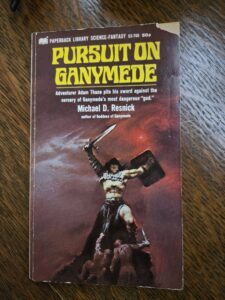Michael Resnick’s “Pursuit on Ganymede.”

Once upon a time, Powell’s Books in Portland used to be a trove of used paperback treasures at prices a hungry college student could afford. Now when I happen to visit PDX (to see old friends, family, visit clients, etc.) I still stop in to browse. Gone are the days of bargain prices. But still in the spinner rack labeled (if I recall correctly) “buy it for the cover” you can find somewhat discounted books. It was from that rack that I picked up Michael D. Resnick‘s Pursuit on Ganymede.
I soon discovered that this was book two, a sequel to The Goddess of Ganymede (which I may, or may not, get a copy of in the future.) Pursuit, it becomes immediately apparent, is an homage to Edgar Rice Burroughs’ John Carter of Mars books, complete with the opening chapter explaining that the following narrative is being told to another writer who is providing it for publication to us, the readers. The hero, who ended up on Ganymede on a spaceship in the course of events which I no doubt will learn if I ever get the first book, is a prototypical Sword-and-Planet protagonist by the name of Adam Thane. On the lower gravity world of Ganymede (Jupiter’s largest moon) he possesses the leaping ability and greater strength in the tradition of John Carter. This serves him well in the course of the extended pursuit of the villains (survivors, it seems, of the first book) who have abducted his fiancee.
The (short) book is episodic, consisting of very short chapters which fall into a pattern of travel, fighting monsters, capture or entrapment, escape, more fighting, etc. Monster fights are swapped out now and then for battles with Ganymede’s inhabitants, humans with (again in the Barsoom tradition) different skin colors. Most of the standard notes are hit: Adam is enslaved, fights in a gladiatorial arena, is befriended by nobility, is unquestioningly placed at the head of military forces during battles, overcomes psychic assaults by sheer willpower, etc. You get pretty much what you expect, no more and no less.
The love of the source material is unveiled. While Pursuit isn’t a classic, there is a certain pleasure to be found in its earnestness and purity. This is early Resnick, with a publication date of 1968. He went on to a fine, prolific career. This won’t be the first of his books to placed on my shelves.
I’m hoping you will be placing my next book on your shelves. Specifically Cesar the Bravo, which, as of this writing, is about $200 shy of funding on the publisher’s Kickstarter. Almost there and with plenty of time left. But I for one would like to see an illustrated edition. That means stretch goals. So if you haven’t already backed the project, I ask you to consider doing so. Illustrators need to eat too.



